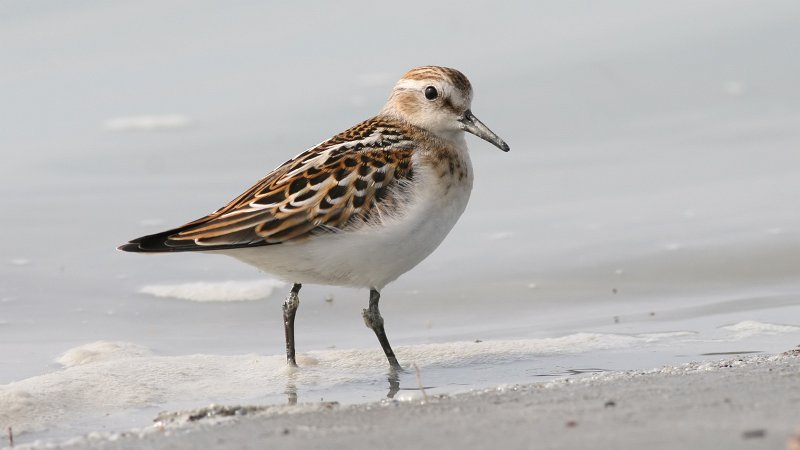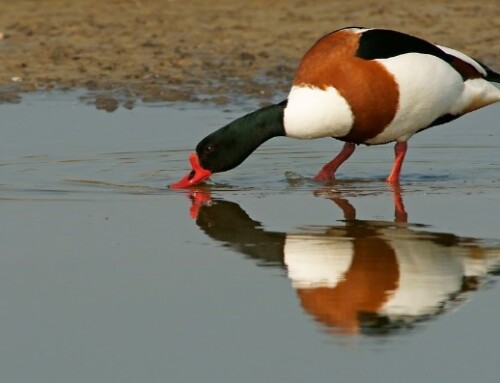 LINKED PAPER
LINKED PAPER
Sex‐specific patterns of fuelling and pre‐breeding body moult of Little Stints Calidris minuta in South Africa. Mazur, A. E., Remisiewicz, M., & Underhill, L. G. 2021. IBIS. DOI: 10.1111/ibi.12848. VIEW
Some little stints (Calidris minuta) migrate over 12,000 kilometers between their wintering grounds in South Africa and their breeding areas in Siberia. To undertake this impressive journey, these small waders fuel up by storing proteins and fat in their bodies. However, while they are at their wintering grounds, little stints also start moulting which involves the fast turnover of body proteins and a large energy investment in the production of new feathers (Jenni-Eiermann & Jenni 1996). To avoid the conflicting energy allocations of fueling up and moulting, most migrating species separate these two processes in time. Little stints, however, seem capable of simultaneously moulting and fueling when there is abundant food (Remisiewicz & Avni 2011). Indeed, in South Africa, both processes overlap as little stints begin fueling up about one month after their pre-breeding moult has started.
Early males
Although both sexes of the little stint fuel up at the same rate, males start their migration a few weeks earlier than females. Males need to arrive early at their breeding grounds in order to secure a territory (Kokko 1999). This decision has a big impact on the migration strategy of the males. The heaviest males are up to 18% lighter than the heaviest females, and they have not completed their moult yet. This means that males can only fly short distances and need several stop-over sites to fuel up again and continue their moult. Females remain on the wintering ground longer and accumulate more fuel, allowing them to migrate over longer distances. Although they do not need to compete for territories, it does benefit females to reach the breeding grounds early so that they can lay two clutches.

Figure 1. The percentage of males caught in South Africa decreases over time. Males migrate earlier in order to quickly reach the breeding grounds and establish a territory.
Two clutches
Little stints have a peculiar mating system. Both sexes engage in successive bigamy (i.e. two consecutive partners). The female produces a first clutch with male #1 and then lays a second clutch with male #2. The first male will incubate the first clutch and the female will incubate the second one. And what about the second male? He takes care of the clutch of his first female. Based on the long migration distances and the production of two clutches, the little stints are probably income breeders, which means that they rely on the food supply at their breeding grounds to produce eggs (Klaassen et al. 2001). Once the eggs hatch and the young have been raised, the little stints return to their wintering grounds and the cycle starts again.
References
Jenni‐Eiermann, S. & Jenni, L. (1996). Metabolic differences between the postbreeding, moulting and migratory periods in feeding and fasting passerine birds. Functional Ecology 10: 62– 72. VIEW
Klaassen, M., Lindström, Å., Meltofte, H. & Piersma, T. (2001). Arctic waders are not capital breeders. Nature 413: 794. VIEW
Kokko, H. (1999). Competition for early arrival in migratory birds. Journal of Animal Ecology 68: 940– 950. VIEW
Remisiewicz, M. & Avni, J. (2011). Status of migrant and resident waders, and moult strategies of migrant waders using African inland wetland habitats, at Barberspan Bird Sanctuary in South Africa. Ibis 153: 433– 435. VIEW
Image credits
Top right: Little Stint (Calidris minuta) | Ken Billington | CC BY-SA 3.0 Wikimedia Commons
Blog posts express the views of the individual author(s) and not those of the BOU.
If you want to write about your research in #theBOUblog, then please see here




